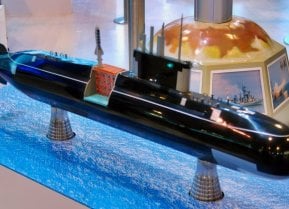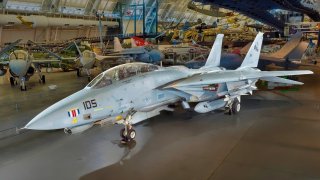Super Tomcat 21: The 'New' F-14 Fighter That Could Have Been a Game Changer
While the F-14D took on the title “Super Tomcat,” this effort to modernize the F-14 began under the moniker “ST21,” which, appropriately enough, stood for “Super Tomcat for the 21st Century,” and make no mistake — that’s precisely what it could have been.
ASF-14: The Ultimate Tomcat
While both the ST21 and AST21 were billed as both re-manufacture programs for existing Tomcats and new-build aircraft, Grumman’s pitch to the Navy eventually included an entirely new-build Tomcat dubbed the ASF-14. The ASF-14 would have looked like its F-14 predecessors, but the similarities would have been largely skin deep.
While the Super Tomcat 21 designs would have increased the Tomcat’s internal fuel storage to 18,500 pounds, the ASF-14 design added thicker wings (much like the Super Hornet versus the Hornet) to further increase fuel capacity. Other improvements over the ST21 and AST21 designs largely revolved around the fact that the ASF-14 would be an entirely new aircraft, so Grumman wouldn’t be stuck working with many of the bulky legacy subsystems that an upgrade/remanufacture program would leave in place as a cost and time-saving measure.
That would mean this new “ultimate” Tomcat’s internals would have been state-of-the-air from nose to tail. Dated and bulky electrical systems would have been replaced with modern modular systems that would not only improve performance and reduce weight, but would have made subsequent improvements cheaper and less time consuming. Perhaps most important to the Tomcat’s ability to survive budget cuts, its troublesome electronic and hydraulic systems that made the aircraft such a maintenance nightmare would have been gutted in favor of modern systems that required less upkeep and weighed substantially less. Even parts of the aircraft that had always worked well would see improvements in materials used, with carbon fiber replacing titanium or aluminum in a number of components.
In fact, even with carrying all that extra fuel, the new ASF-14 Super (Duper?) Tomcat would have weighed in at very close or perhaps even less than the Navy’s existing F-14s thanks to the massive weight savings allowed by the ASF-14 design.
When it first took to the skies, the Tomcat was built to house the massive and incredibly powerful Hughes AWG-9 fire control radar, which remains the largest radar system ever employed by an American fighter. All that real estate would have come in handy for a large active electronically scanned array (AESA) radar for air-to-air and air-to-ground operations.
The ASF-14, with some 60,000 pounds of thrust and a better thrust-to-weight ratio than the F-14D, thrust vector control, massive internal fuel stores, huge payload capabilities, and incredible situational awareness provided by powerful onboard radar and a multitude of sensor pods, could have been a 4th generation fighter with few — or maybe no — peers to this very day.
The Super Tomcat versus the Super Hornet
So if these designs were so good, how did find ourselves here, waxing poetic about how incredible they could have been? Well, like all military acquisitions, the Navy had to balance capability with capacity, mission requirements with budgets, and public perception with military doctrine. The Super Hornet the Navy ultimately chose doesn’t stir the same passion among many aviation fans as the F-14 Tomcat for many of the same reasons it’s proven itself to be such a solid choice for the Navy: It’s a little boring compared to the high drama that comes as part of the F-14’s package.
In a lot of ways, the F-14 was like Rocky of movie fame: a troubled past and a rocky start ultimately produces an American powerhouse that becomes the star of its own movie. Couple that with the F-14D’s genuinely incredible performance and the near-constant threat of nuclear Armageddon and its no wonder we fell in love with this dynamic aircraft.
The Super Hornet, on the other hand, has been characterized as an “80%” solution to the Navy’s litany of problems at the time. It’s not as fast or as powerful as many other fighters and it certainly lacks the range of the F-14, let alone the steroid-injected range of the ASF-14… but it’s reliable, efficient, and battle proven. In fact, America’s only air-to-air kill of the past two decades was scored by a Super Hornet.
It’s tough to argue that the Navy made the wrong call with the Super Hornet, as its reliability and efficiency were both on full display throughout the past two decades of the Global War on Terror. But now, as the the U.S. shifts its focus back toward Great Power Competition, the ASF-14, with it’s insane range, powerful radar, bonkers speed, and spine-crunching agility, looks as appealing as any non-stealth fighter could.
America’s carrier-based fighters are struggling with a lack of range today, something numerous programs are currently working to offset, thanks in large part to the size of China’s area denial bubble created by hypersonic anti-ship missile systems. The Super Tomcat 21 or ASF-14 would lack stealth, just like the Super Hornet, but they could have had the legs they’d need to engage those weapons while keeping America’s carrier’s safely out of range. Today’s F-35Cs and F/A-18s simply don’t.
Of course, aviation technology continues to steam ahead, and even if the ASF-14 had entered service by the end of the 1990s, it would likely still be flying toward an early retirement in favor of the Navy’s F/A-XX fighter being developed in conjunction with the Air Force in the Next Generation Air Dominance (NGAD) program. With stealth increasingly a requirement for new designs, it seems the years of people saying “they never should have retired the F-14” may soon be coming to an end.
But for now, those of you who have long reveled in that salty declaration can rest easy knowing that the Super Tomcat 21 or ASF-14 could have been some of the greatest fighters the world has ever seen.
About the Author
Alex Hollings is a writer, dad, and Marine veteran who specializes in foreign policy and defense technology analysis. He holds a master’s degree in Communications from Southern New Hampshire University, as well as a bachelor’s degree in Corporate and Organizational Communications from Framingham State University. This first appeared in Sandboxx news.
All images are Creative Commons.


